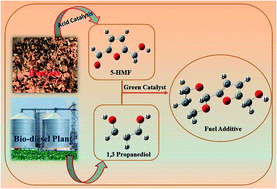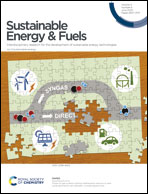Synthesis of an oxygenated fuel additive from a waste biomass derived aldehyde using a green catalyst: an experimental and DFT study†
Abstract
Herein, we report greener and sustainable synthesis of a green fuel additive using protic ionic liquid (PIL) catalysts from biomass derived 5-HMF and 1,3-propanediol. The synthesized PIL catalysts were characterized using spectroscopic techniques such as 1H NMR, 13C NMR, and UV-visible spectroscopy. PIL catalyst [IL-SO3H][CF3SO3] gave a 99.2% 5-HMF conversion and 86.8% yield of the 5-HMF cyclic acetal in 2.5 h. The time, temperature, and molar ratio of the reactants for the 5-HMF conversion were optimized with the most active catalyst. Further, theoretical DFT calculations were performed for the PIL catalyst to calculate ion-pair interaction energies which revealed the activity of the catalyst. From DFT calculations, the interaction and dissociation energies of the ion-pairs of the PILs were determined. Further, the values of the chemical potential (μ) and chemical hardness (η) of the PILs were investigated using DFT. The experimentally determined Hammett acidity values of the catalysts were found to be in good agreement with the theoretical DFT study.



 Please wait while we load your content...
Please wait while we load your content...